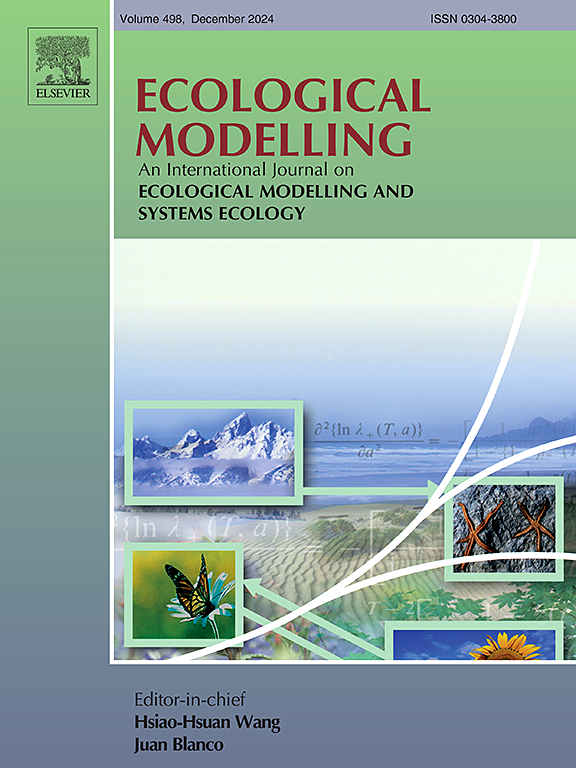Modelling the dynamics of soil moisture and soil water salinity in tropical saltmarshes
IF 2.6
3区 环境科学与生态学
Q2 ECOLOGY
引用次数: 0
Abstract
Tropical saltmarshes share the intertidal zone with mangroves. In contrast to saltmarshes of temperate latitudes, these only occupy the uppermost niche of the intertidal zone, and are characterised by periods of severe drought and hypersalinity in the upper soil during dry seasons. Like mangroves, they show pronounced species zonation patterns along elevation gradients. The primary driver behind these soil water patterns is the variation in tidal flooding frequency, especially notable in the upper tidal zone. Precipitation is the second main source of water, and evapotranspiration and plant transpiration are further factors shaping soil water dynamics and driving plant growth. To describe and comprehend the soil water processes and their dynamics in tropical saltmarshes, we introduce the hydrological model SALTFRED. This model aims to mechanistically predict soil water salinity and root zone soil moisture, elucidating the intricate differentiation of drought and salt stress within the saltmarsh. The model explicitly describes processes of infiltration, seepage and evapotranspiration, along with their influence on the salinity of the soil water. We demonstrate its suitability with an application to a specific study site on the Bragança Peninsula (Pará, Brazil). Utilising complete time series of tidal data and precipitation (for the year 2015), we predict drought and salt stress and compare simulated levels of stress with tolerance levels of the dominant vegetation types and saltmarsh species. Extreme salt and drought stress are defined as salt concentrations of 90 parts per thousand (ppt) and plant available water of 0.5 vol% (0.005 cm³ water per cm³ of soil), respectively. The results suggest that mangrove vegetation thrives where these extreme stress conditions are persistently not reached due to regular flooding by the tides. In the saltmarsh, as elevation increases and the frequency of spring tide flooding decreases, longer periods without water infiltration occur. As a result, the duration of salt stress events increases. In the higher parts of the saltmarsh, additional drought stress is predicted. Our results confirm a robust correlation between simulated levels of seasonally varying drought and salt stress and tolerance levels of the dominant saltmarsh species Rhynchospora riparia, Fimbristylis cymosa, and Sporobolus virgincus at the study site.
热带盐沼土壤水分和土壤水盐度动态模拟
热带盐沼与红树林共享潮间带。与温带地区的盐沼相比,这些盐沼只占据潮间带的最上层生态位,其特点是在干旱季节,上层土壤会出现严重干旱和高盐度的时期。像红树林一样,它们沿着海拔梯度显示出明显的物种分区模式。这些土壤水分模式背后的主要驱动因素是潮汐洪水频率的变化,特别是在上潮带。降水是第二大水分来源,蒸散发和植物蒸腾是影响土壤水分动态和驱动植物生长的进一步因素。为了描述和理解热带盐沼土壤水分过程及其动态,我们引入了水文模型SALTFRED。该模型旨在对盐沼土壤水分盐度和根区土壤水分进行机械预测,阐明盐沼干旱和盐胁迫的复杂分化。该模型明确地描述了入渗、渗流和蒸散发过程及其对土壤水盐度的影响。我们通过在布拉干半岛(巴西帕尔)的一个特定研究地点的应用证明了它的适用性。利用完整的潮汐数据和降水时间序列(2015年),我们预测了干旱和盐胁迫,并将模拟的胁迫水平与优势植被类型和盐沼物种的耐受水平进行了比较。极端盐胁迫和干旱胁迫的定义分别是盐浓度为千分之90 (ppt)和植物有效水分为0.5 vol%(每cm³土壤0.005 cm³水)。结果表明,由于潮汐的定期泛滥,这些极端压力条件一直没有达到,红树林植被茁壮成长。在盐沼中,随着海拔的升高,大潮洪水的频率降低,没有水入渗的时间变长。因此,盐胁迫事件的持续时间增加。在盐沼的较高部分,预计会有额外的干旱压力。我们的研究结果证实,在研究地点,模拟的季节性干旱和盐胁迫水平与优势盐沼物种Rhynchospora riparia, fibristylis cymosa和Sporobolus virgincus的耐受性水平之间存在强大的相关性。
本文章由计算机程序翻译,如有差异,请以英文原文为准。
求助全文
约1分钟内获得全文
求助全文
来源期刊

Ecological Modelling
环境科学-生态学
CiteScore
5.60
自引率
6.50%
发文量
259
审稿时长
69 days
期刊介绍:
The journal is concerned with the use of mathematical models and systems analysis for the description of ecological processes and for the sustainable management of resources. Human activity and well-being are dependent on and integrated with the functioning of ecosystems and the services they provide. We aim to understand these basic ecosystem functions using mathematical and conceptual modelling, systems analysis, thermodynamics, computer simulations, and ecological theory. This leads to a preference for process-based models embedded in theory with explicit causative agents as opposed to strictly statistical or correlative descriptions. These modelling methods can be applied to a wide spectrum of issues ranging from basic ecology to human ecology to socio-ecological systems. The journal welcomes research articles, short communications, review articles, letters to the editor, book reviews, and other communications. The journal also supports the activities of the [International Society of Ecological Modelling (ISEM)](http://www.isemna.org/).
 求助内容:
求助内容: 应助结果提醒方式:
应助结果提醒方式:


